Virtual Storm has grown in the Halo scene at a remarkable rate over the past few months. That rapid growth is definitely impressive, but what makes the organization special is how they did it. With only two amateur Halo teams and a handful of streamers, Virtual Storm attracts the type of attention some pro league organizations struggle to get.
Virtual Storm has provided financial assistance to many amateur players, granting them an opportunity to compete at events they possibly wouldn’t have been able to attend otherwise. This has allowed the organization to earn a high level of respect in the scene.
This generosity, however, raises some questions too. Why is Virtual Storm investing so much in this specific area of competitive Halo? Why spend time investing in an amateur player and team, if you have the resources to possibly pursue a pro league team?
Dot Esports recently spoke with Christopher “Thing 1” Cacciabaudo, the CEO of Virtual Storm, to understand his motive in this scene, as well as his take on what Halo needs to progress.
What was your primary mission when you started Virtual Storm?
Christopher: “My primary mission was to make an organization that was more ‘family oriented’ than others. I wanted to make an organization where players didn’t have to worry about being kicked off the team because a few wanted them out so they can focus more on growing.”
Why do you invest so much of your time and resources in Halo?
“Halo is in a bad state right now, but the reason I continue to invest in it is because I’ve been in this scene for so long. I’ve seen how big the amateur scene is and the amateur scene is what fuels Halo, and it’s very underrated. There is too much going on in the pro scene at the moment and I don’t want that. I can spend $2,000 or $3,000 on a good team with an opportunity to go somewhere.”
Do you profit from signing amateur Halo teams?
“With Halo, I’m not looking for profit. As a businessman who has owned companies, I know what it would take to make money. If you have any teams outside of the top four teams, it’s crippling cause organizations take 20 to 30 percent of the money, and it breaks the backs of the players. A lot more orgs should be more involved in the scene by signing amateur teams with partial funding because this is a really great scene. Halo needs more investments in general.”
What are the primary factors Halo needs to improve on to grow as a scene?
“There needs to be way more open events and they need to be more aware of where they put the events. Events should be somewhat voted on so people can actually attend these events. For example, Vegas. How many people can afford a $600 to $700 plane ticket and a hotel room that’s $180 to $200 a night? We need more open events, smarter locations, and more people who are involved in our community working for HCS, such as Moses and Takedown.”
Do you think production needs to be higher for Halo Championship Series (HCS) events?
“I think people feel like that because they got shied away from MLG. I don’t think we need sound proof booths, but I would agree that production needs to be higher. If we were to have a group like Platinum 5 studios for 95 percent of events, it would be amazing. I feel there is so much untapped talent in this scene that HCS doesn’t take advantage of, and I don’t understand why.”
Finding interest in the amateur scene rather than the professional scene, Virtual Storm is establishing itself as a unique organization with a different vision on competitive Halo. This nontraditional style of investment, considering the resources available to Virtual Storm, can prove to be very rewarding in the future for this team. Virtual Storm could inspire many up-and-coming organizations to follow in its footsteps, if it invests in players who blow up in popularity and reach professional status.






Published: Jul 16, 2017 07:02 pm